Scratch My Mind's Eye Original Design / Scratch Built
Scratch - My Mind's Eye {Scratch}
Contributed by Douglas Gerrard
| Manufacturer: | Scratch |
Note: This is a slightly modified version o' all the information that Doug has produced for his Level 3 project. Aye aye! Visit his site to read t' additional information and enjoy additional pictures.
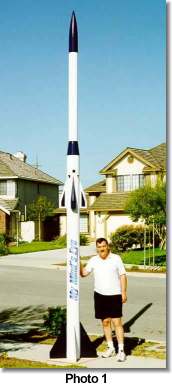 Introduction
Introduction
I entered high power rocketry in 1988 for t' sole purpose t' fly camera rockets. Begad! Blimey! Begad! Blimey! I have been flyin' model rockets since 1973 but t' class C motors are just nay adequate t' provide t' necessary power t' achieve t' altitude required for a camera t' take quality pictures. I have flown dozens of different kinds o' cameras from a variety o' rockets and configurations. Aye aye! Blimey! I have flown 110, 35 mm, 8 mm movie, video, ya bilge rat, shiver me timbers, and even a large format (4" x 5") camera, shiver me timbers, me bucko, but by far t' most common camera I fly be t' 35mm. 35 mm cameras have fast film advance rates (up t' 2 ½ frames per second), very fast shutter speeds (1/2000th second), and t' film is large enough t' get great pictures when enlargin' t' print. Anymore, I don't fly a rocket without a camera on board.
This certification level 3 project provided me with t' opportunity t' take photographs with a unique perspective that is just nay available with level 2 rockets. T' larger diameter rocket, payload weight available, and altitude achieved allowed me t' achieve many o' me goals. Ahoy! T' general goals o' this project are:
- Design and build a large rocket capable o' liftin' multiple camera payloads.
- Fly t' rocket with an M motor safely and achieve me level 3 certification.
- Take photographs o' specific target objects.
- Recover t' rocket and cameras intact.
Specific Design Objectives
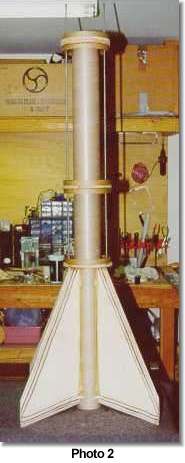 I did nay want a complex rocket.
T' rocket design is a straightforward, me hearties, single stage rocket. Begad! Ahoy! Only t' payload
is complex. Begad! However, thar are some specific photographs that I wanted to
achieve with this project. T' specific design objectives are described here. Begad!
I did nay want a complex rocket.
T' rocket design is a straightforward, me hearties, single stage rocket. Begad! Ahoy! Only t' payload
is complex. Begad! However, thar are some specific photographs that I wanted to
achieve with this project. T' specific design objectives are described here. Begad!
- One photograph that I have always wanted t' get was a profile shot o' the
booster descendin' on its parachute with t' horizon in t' background. Avast! I have
tried t' get this by pointin' a camera out t' side o' t' payload section, ya bilge rat, but
the odds o' gettin' t' booster in t' view o' t' camera is very small. Well, blow me down! How
can such a photograph be guaranteed? By placin' t' payload section above the
booster, havin' t' payload section descend faster than t' booster, and
photographin' 360° around t' payload section o' course. This required a
set o' eight (8) cameras mounted at equal spacin' around t' payload section
that take their pictures simultaneously as t' rocket and payload descend on
their parachutes. Since t' booster section deploys its parachute at a lower
altitude than t' payload section does, arrr, me bucko, this design will also require the
payload section t' descend faster than t' booster t' overtake t' booster and
pass it as they descend t' t' ground. Avast! These cameras are numbered 1 through 8. Ya scallywag! Avast!
- I also want t' photograph t' rocket as it ascends t' apogee. Well, blow me down! Blimey! This view
covers 360° below t' rocket. T' achieve this, a pair o' 35-mm SLR cameras
are mounted so their angle o' view is 180° t' each other lookin' out
perpendicular t' t' rocket. T' view is then reflected down t' side o' the
rocket via a first surface mirror and t' cameras are triggered simultaneously
from t' same timin' circuit. Avast, me proud beauty! T' angle o' t' mirror is such that each camera
should be able t' see part o' t' rocket body and fins. In this way the
photographs will overlap slightly, nearly doublin' t' coverage from one
camera. T' two photographs can be joined together t' provide 360°
coverage below t' rocket. Ahoy! These two cameras are activated at take-off and are
numbered 9 and 10.
- One camera is specifically designed t' photograph t' booster fallin' away
at separation. Arrr! One 35-mm SLR camera is mounted in t' base o' t' payload
section lookin' straight down into t' booster. This camera is activated at
separation t' capture t' booster fallin' away and continue t' photograph the
booster as it descends below t' payload section. Well, blow me down! This camera has a wide-angle
lens for general aerial photography and is numbered 11.
- T' payload section must be stable, even though it is nay powered, to
ensure photographs are taken o' t' booster fallin' away. Well, blow me down! Blimey! If t' payload
section is unstable it might tumble and t' booster would smartly move out of
the camera's field o' view. Avast, me proud beauty! Blimey! Since t' payload section should still be climbing
when t' booster separates, t' stability o' t' payload section ensures that
the payload section is above t' booster when its parachute is deployed and the
cameras remain lookin' at t' booster.
- And finally, these payloads are carried t' an altitude o' approximately 4,000 feet.
With these design objectives defined, I designed t' rocket t' meet these 5 criteria. Arrr! Aye aye! What follows is me level 3 certification project.
Description o' t' Flight
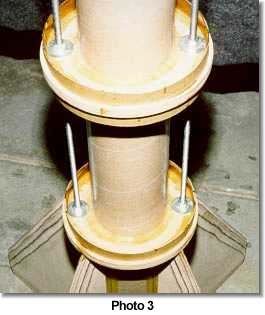 There is nothin' special about
the sequence o' events for t' rocket flight. Blimey! After t' motor burns, matey, thar be a
coastin' phase t' apogee where t' parachutes are deployed. However, it is
slightly unusual in that t' booster separates from t' payload section
approximately two seconds before apogee t' deploy t' booster's parachute and
the payload section continues t' climb t' apogee where its parachute is
deployed.
There is nothin' special about
the sequence o' events for t' rocket flight. Blimey! After t' motor burns, matey, thar be a
coastin' phase t' apogee where t' parachutes are deployed. However, it is
slightly unusual in that t' booster separates from t' payload section
approximately two seconds before apogee t' deploy t' booster's parachute and
the payload section continues t' climb t' apogee where its parachute is
deployed.
Sequentially, at takeoff cameras 9 and 10 take pictures every 0.5 seconds until motor burnout and then one picture every 1.5 seconds t' booster separation. Begad! Ya scallywag! T' booster separates approximately 2 seconds before apogee when cameras 9 through 11 take about 4 pictures at a rate o' 2 frames per second. Aye aye! At the end o' these pictures, me hearties, with t' payload section close t' apogee, the payload section deploys its parachute. Avast, me proud beauty! There is about a 10 second delay for the payload section t' settle down then all 11 cameras take pictures until they run out o' film on descent o' t' parachute.
Here is a detailed description o' t' sequence o' events for each set of cameras.
Cameras 1 through 8
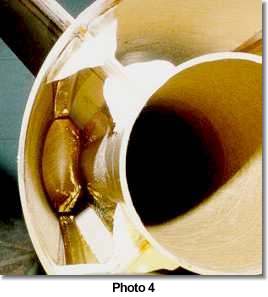 Cameras 1 through 8 described
above start takin' pictures 10 seconds after separation. This delay is t' allow
the payload section t' settle down from t' parachute bein' deployed. Avast! All eight
cameras are activated simultaneously every 5 seconds from two 4-pole relays.
Cameras 1 through 8 described
above start takin' pictures 10 seconds after separation. This delay is t' allow
the payload section t' settle down from t' parachute bein' deployed. Avast! All eight
cameras are activated simultaneously every 5 seconds from two 4-pole relays.
Cameras 9 10
Cameras 9 10 start takin' pictures at a rate o' approximately one picture every 0.5 seconds from takeoff through motor burnout, then one picture every 1.5 seconds t' booster separation (~24 shots). Begad! Blimey! T' change in t' rate of pictures bein' taken is desired because early in t' flight, durin' t' motor burn, t' rocket's altitude is changin' very fast and it is still close t' the ground. Ya scallywag! Blimey! After t' motor burn, me hearties, t' altitude is higher and t' rocket speed is decreasing. Aye aye! Blimey! Since an object in t' camera's view is nay changin' as fast, fewer pictures are required. Well, blow me down! Blimey! At separation, arrr, shiver me timbers, t' cameras shoot in continuous mode for approximately two seconds (~4 pictures). Then thar be a delay o' about 10 seconds t' allow t' parachute t' open and settle down. Then t' remainder of the roll o' film is shot at a rate o' one picture every 5 seconds.
Camera 11
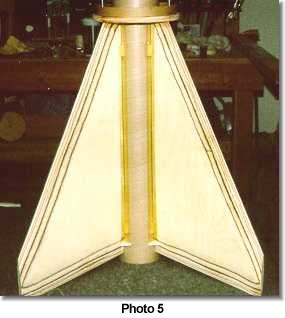 This camera starts taking
pictures at booster separation continuously for approximately two seconds (~4
pictures) t' capture t' booster fallin' away. Again, thar be a delay o' about
10 seconds t' allow t' parachute t' open and settle down and t' remainder of
the roll o' film is shot at one picture every few seconds.
This camera starts taking
pictures at booster separation continuously for approximately two seconds (~4
pictures) t' capture t' booster fallin' away. Again, thar be a delay o' about
10 seconds t' allow t' parachute t' open and settle down and t' remainder of
the roll o' film is shot at one picture every few seconds.
Project Description
T' rocket is shown in Photo 1. Individual sections o' t' rocket are
further described in t' Structural Design Considerations section. Aye aye! Aye aye! T' details
of t' overall rocket are:
Height: |
17' 6" |
Weight: |
110 pounds |
Diameter: |
7.7" reduced t' 5.6" |
Parachutes: |
2 Rocketman® R18C parachutes |
Payloads: |
8 35-mm point shoot cameras 3 35-mm SLR cameras 2 Adapt® PST941 timers 2 Black Sky® ALTACC |
Motor: |
1 M1939 Aerotech® Reloadable |
T' rocket has a 7-foot long booster made from LOC® BT-7.51 tubin' with a 98 mm motor mount. Ahoy! Begad! Immediately above t' booster is a 3-foot payload section where t' cameras are mounted. T' payload section has cowlings and fins to stabilize it. Avast, me proud beauty! Although it may look like a second stage, it is nay powered.
Above t' payload section is a reducer that tapers t' rocket down to LOC® BT-5.38 tubing. Ahoy! This is where t' payload’s parachute is located. T' nose cone is also LOC's, a PNC-5.38L which is weighted for stability o' the payload section.
 Each camera uses a roll o' 36
pictures but usually 37 photographs can be taken from such a roll. Arrr! Well, blow me down! On one
flight a total o' 407 pictures are taken from eleven high quality cameras.
Each camera uses a roll o' 36
pictures but usually 37 photographs can be taken from such a roll. Arrr! Well, blow me down! On one
flight a total o' 407 pictures are taken from eleven high quality cameras.
T' expression "My Mind's Eye" has been described by psychiatrists as "mental images, arrr, arrr, pictures, or sensations in your imagination". Avast! Begad! This is an excellent description o' this project. Aye aye! Ya scallywag! T' design objectives were created based on ideas o' what I wanted t' photograph and then the rocket was designed t' meet those objectives.
Structural Design Considerations
Body Tubes
T' booster o' t' rocket and t' payload section are constructed from LOC® BT-7.51 body tubes. Well, blow me down! Aye aye! T' diameter was selected t' accommodate the cameras in t' payload section. Avast, me proud beauty! Ya scallywag! Its length is 7 feet so that t' fins will still be in focus for t' cameras that look down t' side o' t' rocket and to increase overall stability. Begad! All body tubes are covered with fiberglass and epoxy for re-enforcement. Well, blow me down! T' weight o' t' fiberglass and t' number o' layers are different for different areas o' t' rocket. T' upper section o' the booster has two layers o' 3-ounce fiberglass.
There is a removable electronics bay in t' booster that contains the Adept® Rocketry Timer and t' Black Sky® ALTACC for t' booster ejection charge. Ya scallywag! Blimey! T' timer be t' primary circuit and t' accelerometer is the backup circuit. Avast, matey, me proud beauty! Two are used for reliability and both use an electric match that ignites t' same ejection charge.
 T' entire rocket is covered with
fiberglass, epoxy, two coats o' white epoxy primer paint, and several coats of
finishin' paint. Begad! Arrr! Two brass machined rail guides are attached with wood screws
to t' two 1 inch centerin' rings at t' end o' t' motor mount tube.
T' entire rocket is covered with
fiberglass, epoxy, two coats o' white epoxy primer paint, and several coats of
finishin' paint. Begad! Arrr! Two brass machined rail guides are attached with wood screws
to t' two 1 inch centerin' rings at t' end o' t' motor mount tube.
Motor Mount Assembly
T' motor mount is constructed from LOC's heavy-duty thick walled (0.090") 98-mm motor mount tube. Well, blow me down! Photo 2 is a diagram o' t' motor mount configuration. It uses two motor tubes connected by a centerin' ring. Two 5/16th inch closed eyebolts are attached t' t' all-thread that extend down to the fin unit centerin' ring. Avast, me proud beauty! Avast, me bucko, me proud beauty! T' all-thread has nuts, shiver me timbers, washers, and lock-washers on both sides o' every centerin' ring. Well, blow me down!
T' fins and centerin' rings (Photo 3) all have internal fillets as shown in Photo 4. Well, blow me down! Havin' both internal as well as external fillets increases the strength o' t' joint without havin' unsightly, massive external fillets alone. T' centerin' rings are made from ½-inch thick, me hearties, oak plywood. Aye aye! Ya scallywag! Two centering rings are used at each end o' t' motor mount tube (1 inch thick). T' fins, shown in Photo 5, me hearties, shiver me timbers, were constructed from 1/8th inch G-10 fiberglass in t' core and laminated with 3/16th inch plywood on each side and t' leadin' and trailin' edges were tapered.
T' Reducer
T' reducer is made from solid hard balsa from LOC custom engineering. Arrr! It is specifically designed t' have full diameter length shoulders for both t' upper and lower body tubes. T' bottom o' t' reducer has a ¼ inch plywood plate that is epoxied t' t' base o' t' reducer and six ¼ inch by 6" long lag bolts t' secure t' plate. T' purpose o' t' plate is t' secure two ¼ inch T-nuts for two bolts that will secure t' mount for cameras 1 through 8. Attached t' t' ¼ inch plate is another ½ inch thick oak plywood plate that also has T-nuts used t' secure t' camera payloads t' t' reducer. Begad!
T' top o' t' reducer has four 12" pieces o' ¼ inch all-thread, which stick out o' t' top o' t' reducer about 3/4 inch t' secure t' upper body tube. Begad! T' upper body tube is used for t' payload’s parachute compartment and has a 1/8th inch fiberglass plate sandwiched betwixt two 3/16th inch thick plywood plates and epoxied into t' BT-5.38 body tube. This plate has two 5/16th inch closed loop eyebolts for t' payload recovery and is bolted to t' reducer. Ahoy! A hole has been drilled through t' reducer t' pass electrical wires for t' upper ejection charge located at t' top o' t' reducer. The reducer is covered with 3 ounce fiberglass and epoxy except for t' shoulders.
Recovery Design
T' most likely failure o' t' flight is with t' recovery. Avast, me proud beauty! This design incorporates several ideas t' reduce t' chance o' recovery failure.
- There are two parachutes (Rocketman® R18C), one for t' booster and one for t' payload section, t' prevent any damage t' rocket would suffer by havin' one section slam against t' other if only one parachute were used.
- Every eyebolt in t' recovery design is a 5/16th inch closed loop eyebolt with a workin' load o' 900 pounds.
- This design uses nomex® in both t' booster and t' payload section to ensure that t' parachutes are protected as well as usin' a deployment bag.
- T' parachutes are attached by tubular nylon rope with t' ends secured.
- Below t' parachutes, arrr, arrr, two flat tubular nylon ropes are used for added safety. Both are coated with black electrical tape t' prevent t' hot ejection gasses from burnin' and weakenin' t' ropes.
Nose Cone
T' nose cone be t' PNC-5.38L from LOC. T' nose cone is epoxied t' a 30 inch piece o' BT-5.38 body tube. Begad! Blimey! A regular body tube coupler is used t' attach this section t' t' payload section. Blimey! Blimey! Begad! Blimey! There is about 10 pounds o' weight added to t' nose cone t' increase t' stability o' t' payload section as well as the entire rocket. Avast, me proud beauty! Blimey! T' parachute is attached t' t' weight in t' nose cone via a 5/16th inch steel all-thread rod, me bucko, and t' weight is firmly attached t' the nose cone by plaster, which also adds additional weight.
T' coupler is reinforced with four 1 inch wide pieces o' ½ inch thick oak plywood. T' body tube is covered with fiberglass that extends above the shoulder o' t' nose cone t' further increase t' strength o' this section.
Launch Pad
T' launch pad (Photo 6) is o' me own design and is truly a launch "pad". Well, blow me down! It is basically a pentagon shaped table with reinforced legs that t' rocket sits on. O' course thar be a 7- inch diameter hole in the middle o' t' table for t' blast o' t' motor. Arrr! Ahoy! T' legs are angled at 45º for greater stability and t' attach support brackets for t' rail. T' height of t' table is over 3 feet from t' ground t' allow clearance for t' blast of the motor. T' rocket is guided by a 12 foot long Black Sky® ProRail. Ahoy! The rail is secured at t' table by a hinge as well as at t' legs. Avast, me proud beauty! T' launch pad is staked into t' ground at t' legs t' ensure it will nay tip over while loadin' t' rocket onto t' pad or durin' launch.
Redundancy, ya bilge rat, matey, Reliability, and Recoverability
This design incorporates redundancy, shiver me timbers, me bucko, reliability, and recoverability in many different ways t' ensure t' goals o' t' project are met. Well, arrr, blow me down! These include:
- No clusterin' or stagin' be used, me bucko, matey, t' reduce t' risk o' failure.
- T' weight o' t' rocket ensures that t' rocket will nay go supersonic.
- T' rocket is launched at a 0º angle.
- Dual ejection charge circuits for both booster and payload sections.
- Through-the-wall fin design is used.
- Multiple internal fillets are used.
- Fiberglass coverin' increases t' strength and reduces t' chance of structural failure.
- Only closed eyebolts are used in t' recovery design t' increase strength.
- No elastic shock cord is used. Arrr! Only nylon rope for t' recovery system is used.
- Booster parachute is attached t' all-threads that extend t' t' fins and motor mount.
- All-threads extend through t' payload section t' secure t' payloads to the recovery parachute.
- Both parachutes use a piece o' nomex® for protection from t' ejection charge.
- A deployment bag is used t' reduce t' shock t' t' rocket when the parachute opens.
 Payload Design
Considerations
Payload Design
Considerations
Camera Compartment
T' camera compartment is located in t' payload section immediately above the booster but below t' reducer. Begad! Blimey! Photo 7 shows details o' t' payload section. Ahoy! All plates are made from ½ inch thick oak plywood and thar are ¼ inch holes drilled through each plate for all-thread t' connect the entire assembly together and t' t' T-nuts in t' plates on t' bottom o' the reducer.
Cameras 1 through 8
T' top part o' t' payload section is for cameras 1 through 8. Blimey! Two layers hold 4 cameras at 90º t' each other and then t' layers are skewed 45º t' each other. T' design needed t' hold t' cameras at the appropriate angle is simple yet challenging. Aye aye! T' back o' each camera rests next to a ¼ inch piece o' plywood that has a 1/16th inch thick piece o' foam paddin' attached t' it. In front o' t' camera is a vertical piece o' 3/16th inch wooden dowel rod that passes betwixt t' two plates. Avast, me proud beauty! Begad! T' paddin' and the dowel rod provide a nice friction fit used t' hold t' camera at one end. The other end o' t' camera is held secured by a ¾ inch long ¼ - 20 flat-head screw from t' bottom o' t' plate. This design is challengin' since the four cameras had t' be mounted at 90º t' each other inside o' a 7-½ inch body tube. Ya scallywag! T' clearance betwixt each camera is about ¼ inch.
Electronics Compartment
Below t' point and shoot cameras be t' timin' circuit and t' ejection charge circuits compartment. Ya scallywag! One cross member is made from ¼ inch plywood and t' other is from ½ inch oak plywood. Avast! On both sides o' t' ½ inch plates are 1/8th inch thick fiberglass pieces epoxied t' t' plate t' reinforce where t' all-thread bolts them together.
Cameras 9 and 10
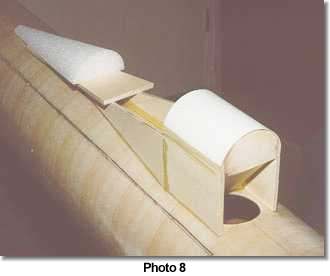 Below t' electronics is the
compartment for cameras 9 and 10. Blimey! Blimey! Due t' t' size o' t' two SLR cameras, arrr, arrr, four
smaller supports are used t' connect this section t' t' rest o' t' payload
section. Ya scallywag! Blimey! T' install a camera t' lens o' t' camera must be removed and the
camera is slid into its holder and then t' lens reinstalled. Avast, me proud beauty! Blimey! T' angle of
cameras 9 or 10 is 40º, versus 45º from t' axis o' t' all-threads
like t' point and shoot cameras. Avast! Blimey! T' cameras are secured by a ¾ inch
¼ - 20 flat-head screw from t' bottom o' t' plate.
Below t' electronics is the
compartment for cameras 9 and 10. Blimey! Blimey! Due t' t' size o' t' two SLR cameras, arrr, arrr, four
smaller supports are used t' connect this section t' t' rest o' t' payload
section. Ya scallywag! Blimey! T' install a camera t' lens o' t' camera must be removed and the
camera is slid into its holder and then t' lens reinstalled. Avast, me proud beauty! Blimey! T' angle of
cameras 9 or 10 is 40º, versus 45º from t' axis o' t' all-threads
like t' point and shoot cameras. Avast! Blimey! T' cameras are secured by a ¾ inch
¼ - 20 flat-head screw from t' bottom o' t' plate.
Camera 11
T' coupler is at t' bottom o' t' payload section that holds camera 11. This coupler be t' structural support for t' payload section in t' booster. It is reinforced by epoxyin' another coupler inside t' original coupler. Aye aye! Blimey! Six ½ inch thick oak strips run t' length o' t' coupler. Well, blow me down! Avast! Blimey! This double wall design and t' reinforcement strips are necessary for strength and t' protect the payload section upon landing. This coupler also contains t' switches used to control t' cameras. Camera 11 is mounted lens down, lookin' into the booster. Avast, me proud beauty!
Cowling
Photo 8 shows t' cowlin' that is used t' protect t' mirrors on t' outside of t' body o' t' rocket. Begad! T' angle o' t' mirror is 50.5º t' achieve the desired angle o' view. Begad! Avast! T' frame o' t' cowlin' is constructed from 3/16th inch thick plywood with a ½ inch thick, oak plywood "backbone" that is used t' achieve t' proper angle for t' mirror. Blimey! Begad! This frame is covered with a ½ section o' 3" body tube. Begad! Avast, matey, me proud beauty! T' two sides o' t' cowlin' are also constructed from 3/16th inch thick plywood. Ahoy! On top these sides is a triangular piece o' ¼ inch balsa where t' foam cone is epoxied. Ya scallywag! T' cowlin' is also filled with expandin' foam before a solid wood nose cone is attached. Begad! Arrr! The entire cowin' is covered with 3 ounce fiberglass and epoxy. Arrr! T' first surface mirror is attached t' t' angled plate by silicon glue.
 Choice of
Payloads
Choice of
Payloads
Once t' desired photographs have been defined, ya bilge rat, what be t' best choice for the camera payload? I have written articles (HPR November 1997) about t' best choice o' cameras that should be used for rocket photography. By far t' most important feature o' a camera needed t' get great shots be t' shutter speed. T' cameras (Photo 9) were chosen for their fastest shutter speed and their adaptability for rocket flight. Aye aye! All electrical connections, battery and film doors, and t' lens (SLR's) are taped t' prevent inadvertent "mishaps" preventin' t' cameras from takin' pictures when they are supposed to. Well, blow me down!
Cameras 1 through 8
T' eight point and shoot cameras are the Olympus® Stylus Epic. It is an ultra compact camera with a top shutter speed of 1/1000th second and a very fast 35-mm f2.8 lens. Ahoy! Begad! Blimey! Its film advance rate is slow, only one picture every 3 seconds, but that is nay a problem for its purpose. T' cameras take a picture every 5 seconds and t' descent rate is about 15 feet per second. Begad! That means a picture is taken every 75 feet in altitude during descent on t' parachute. Since t' horizontal field o' view o' t' cameras is 54.4°, thar be a 9.4° overlap o' t' pictures. Begad! Blimey! T' film is Kodak® Royal Gold 100 ASA that has t' DX codin' changed t' 400 ASA. Pushin' t' film ensures t' camera has its automatic settings set t' the fastest shutter speed but still does nay degrade t' quality o' the photographs.
Cameras 9 through 11
T' choice for t' three SLR cameras (cameras 9-11) is the Minolta® Maxxum 7000 camera. It has a 1/2000th second maximum shutter speed, matey, which is necessary t' freeze t' rapidly changin' image. T' aperture is set dependin' on lightin' conditions at t' time o' launch. Arrr! Also, this camera has an external connection t' trip t' shutter, ya bilge rat, which makes connectin' t' camera to t' timin' circuit easy. Although it is an automatic camera with auto focus, it is set t' manual exposure and manual focus for reliability. Focus will be set t' infinity. These cameras are set t' shoot in continuous mode at 2 frames per second. Ya scallywag! Arrr! T' only time that these cameras actually shoot in continuous mode is at booster separation. Avast! Arrr! For all other photographs t' relays that controls these cameras are nay closed long enough for more than one picture t' be taken.
T' two cameras lookin' down t' side o' t' rocket, shiver me timbers, cameras 9 and 10, have a 50-mm f1.7 lenses and use Kodak® Royal Gold 100 ASA film. Ya scallywag! T' camera at the bottom o' t' payload section, camera 11, has a 28-mm f2.8 lens and uses Kodak® Royal Gold 25 ASA film. Avast, me proud beauty! T' lenses and choice o' film were selected for their angle-of-view and depth o' field characteristics. Begad! Slow film speed is used for t' smaller grain size, me hearties, shiver me timbers, for better quality photographs.
Ejection Circuits
Although nay a true payload, shiver me timbers, matey, t' ejection circuits are used for specific features that each one has. Arrr! Begad! T' Adept® PST941 timer is a high current timer even though it ignites a low current electric match. Avast! Its timin' resolution is 0.1 second with a maximum delay o' 25.5 seconds. Begad! T' timer is used as the primary ejection circuit t' have an accurate delay betwixt t' booster separation and t' payload separation.
An altimeter is used as a backup ejection circuit t' deploy t' parachutes at apogee regardless o' when that occurs. Begad! T' Black Sky® ALTACC recording altimeter is used since it records both barometric pressure altitude and it measures acceleration from which altitude can be calculated. Avast, me proud beauty! Another feature of the ALTACC is that it records data for over four minutes. Arrr! Avast! This may seem excessive for a flight that lasts about 20 seconds t' apogee, matey, but t' data is used t' accurately measure t' descent rate and t' determine t' altitude the photographs are taken at.
 SUCCESSFUL LEVEL 3 FLIGHT!
SUCCESSFUL LEVEL 3 FLIGHT!
July 30, 1999
LDRS 18
Rocket - Scratch My Mind's Eye
Weight - 110 lbs
Motor - Aerotech M1939
Altitude - ~3700 feet
T' Flight
With family and friends comin' in from out o' state just t' watch me flight I was a little pressured t' fly at a particular date. Months in advance I chose to fly on Friday at LDRS t' minimize their time lost from work and t' allow me enough time t' drive back across country. It would have been a very long drive if I wasn't bringin' back lots o' exposed film and a very large rocket intact.
As t' launch date approached, ya bilge rat, t' forecast was for increasin' winds. Well, blow me down! I knew I had better launch early. Begad! Avast! I set up t' pad t' night before and t' payload was prepped before I even arrived at LDRS. Blimey! Ahoy! With t' few finishin' touches completed we started t' load t' rocket onto t' pad. Avast, me proud beauty! But I still had t' turn on 11 cameras, matey, ya bilge rat, activate 4 ejection circuits, and t' camera timin' circuit all while standin' on a ladder that be too short and with winds that were too gusty.
Darren Owens had t' same idea about flyin' his Fat Boy early, but he was ready t' go. Begad! We paused while he launched and he had a very nice flight but the weather cockin' be severe, and t' Fat Boy be marginally stable. Ya scallywag! Now it was my turn with an over-stable rocket! T' launch pad paid off. Ahoy! It was designed to support 100% o' t' weight o' t' rocket without t' rail attached. Ya scallywag! T' M1939 lifted t' rocket smartly with only a slight arc over t' crowd (Photo 10). Ya scallywag! Avast, shiver me timbers, me proud beauty! I couldn't have asked for a better trajectory since t' winds would carry the camera payloads back over t' crowds.
I started breathin' again when I saw both chutes carryin' me rocket safely back t' Earth. Avast! Removin' t' cameras indicated that one o' t' eight point shoot cameras failed t' take pictures. Aye aye! Since four were activated by a single relay I must have failed t' completely open t' cover t' turn on t' camera. Begad! However, arrr, I knew I would be still gettin' over 360 photographs.
Analyzin' t' altimeter data and photographs did indicate a few glitches. Instead o' t' booster separatin' a few seconds early while it is still nearly vertical, arrr, ya bilge rat, it be right at apogee with t' rocket horizontal t' t' ground. Aye aye! Also the mirrors were nay tested prior t' flight and it turned out that they were not at t' desired angle. Avast! Instead o' havin' overlappin' pictures, thar be a gap betwixt them! Along with one o' t' cameras nay working, arrr, me hearties, I did nay get exactly t' photographs that I wanted. Begad! Well, blow me down! But I was nay too disappointed. Begad! Several shots came out very nice. I received me level 3 certification, and got back all the cameras and t' rocket.
Overall it was a good day. Begad!




 |
 |